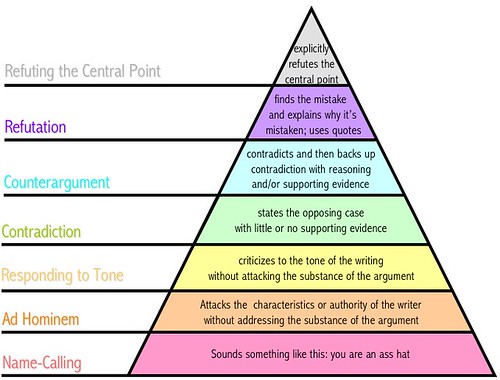
As an analyst, we undergo training then are put to the test to stand by our calls, and back it up with data, insight, experience, or facts. I found this diagram published by the create debate blog, and by using the creative commons license they have on their blog, am sharing it with you. The graphic is spurred by the essay written by Paul Graham How to Disagree, start there.
Since I tie just about everything back to internet strategy, let’s take this fictional example of one of your colleagues who has spent significant budget on advertising popups on a C rated media site in your market. You, the social media strategist at your company, is less than thrilled to see this, but you need to think about different ways to approach this
Using Graham’s Hierarchy, here’s some fictional arguments you could use to persuade your colleague with the advertising-popup plan:
Refuting the Central Point: Regarding your advertising-popup tactic, we should refocus our core strategy on using marketing channels that allow us not only tell our message, but leave prospects with a positive brand impression, and the desire to take the next step with us. (notice that I focused on the objective, without even criticizing the popups, nor the person)
Refutation: I’d like you to reconsider your advertising-popup tactic, as most users don’t like them, in fact Treester Research shows that 26% of those who see popups actually have a negative brand impression.
Counterargument: Advertising-popups are a bad idea, research indicates most users don’t like them
Contradiction: Everyone knows advertising-popups are a bad idea
Responding to Tone: It sounds like you’re frustrated and don’t know what to do
Ad Hominem: So typical of you people to do something stupid
Name-Calling: Your advertising-popup strategy sucks buttocks, ass hat
Caveat: I’m not slamming the pop-up marketing industry, this is just an example, I could have used blogs too.
I remember as a child, the school yard arguments were often at the bottom. Sadly, some bloggers and tweeters are still there. When you talk to executives, I recommend you focus on the end objectives and end results, never on the tools, which moves lower and lower on the pyramid.
So, back to you, what point on the pyramid do you insert your arguments? Be honest, and talk about how you can improve or give an example.
(for what it matters, I quickly fall down the pyramid when I’m dealing with my loved ones, I’m certainly a guilty ass hat)
I find that certain ‘cyclical’ arguments within companies usually start at the top of the pyramid, but with time soon fall to the bottom as we’ve argued the point countless times; ending up with the Ad Hominem or Name Calling as the default response.
Great article. I consistently fall into the 2nd category when trying to present an alternative or a reason for change at work. However, the elegance of the top of the pyramid seems much more likely to be effective. I definitely learned something from this post and will try to make this change. Not sure how easy that will be though.
If any of you would like to practice using some of these techniques in an environment with much less severe consequences than work, I suggest you check out the site that posted the argument hierarchy. It’s called CreateDebate (www.createdebate.com) and I came across it about 2 weeks ago. A lot of good arguments going on over there (at all levels of the pyramid I might add). May be worth checking out to improve your argument skills for more consequential environments.
Not to jump off subject, but your example rings of Cyrano’s list of insults by type.
I still dont get how to make a debate arguement??
This still dont tell me nothing!!